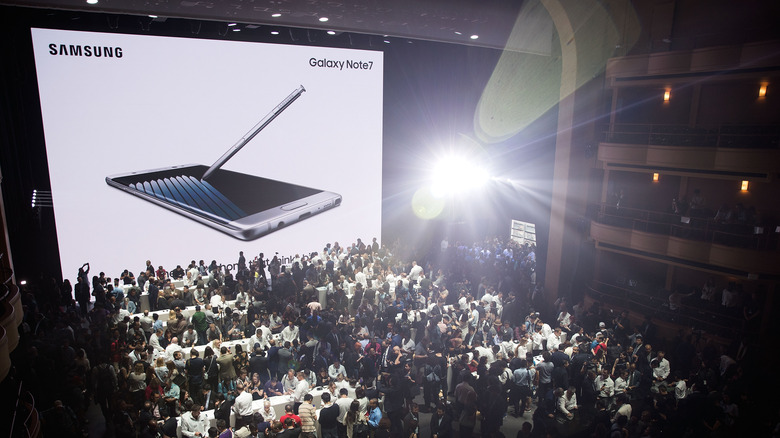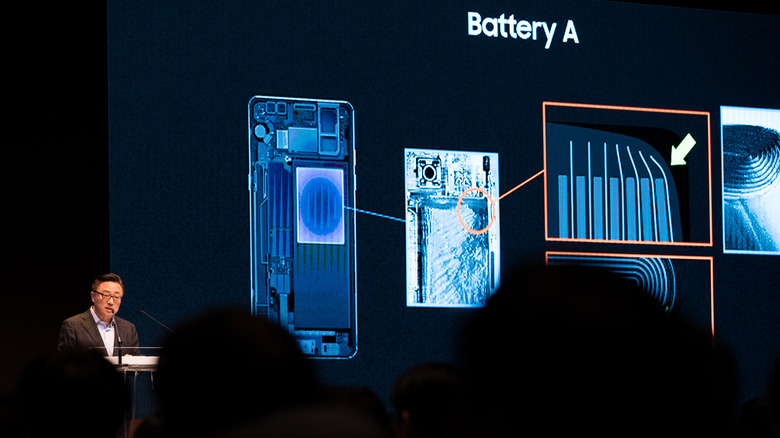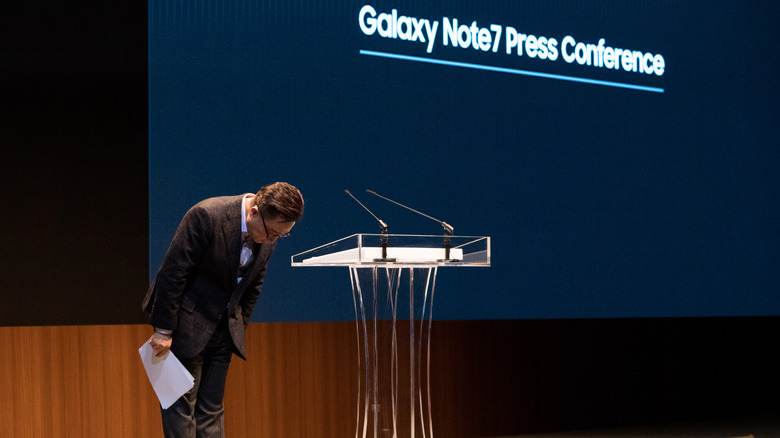The One Failure That Changed Samsung Forever
We may receive a commission on purchases made from links.
Samsung is the number one smartphone vendor in the world, having boasted a global market share of 24% in Q1 2022, according to Canalys. This put it ahead of Apple, which came in second place with a market share of 18%, while Chinese company Xiaomi rounded out the top three positions with a 13% share. However, while it continues to hold a strong lead on smartphone shipments globally, things nearly fell apart for the South Korean company with the launch of its Galaxy Note 7 back in 2016. The model launched to a lot of fanfare and we were impressed with its winning combination of a large (for the time) 5.7-inch Super AMOLED display, solid performance, stunning design, and S-Pen. In fact, we called it the best Android of 2016, a view that was widely shared.
Unfortunately, little did anyone know at the time of its launch that the Galaxy Note 7 would become one of the most infamous smartphone releases of all time, introducing a failure that would change Samsung forever. We have all seen the issues that can arise with the lithium-ion batteries that power just about every smartphone on the market. If the battery gets damaged from a drop or if an incorrect charger is used with it, things can get ugly pretty quickly. Why? This type of battery is prone to combusting, catching fire, and even exploding under such circumstances. Thankfully, however, in most instances, these occurrences are few and far between. That wasn't the case for the Samsung Galaxy Note 7, however.
Explosive sales of explosive devices
When the Samsung Galaxy Note 7 went on sale on August 19, 2016, it was an instant hit for the company and sales exploded (via Korea Herald). However, it wasn't too long before Galaxy Note 7 units started to explode literally, and soon after the whole Galaxy Note 7 launch imploded. The first report of a Galaxy Note 7 combusting hit the news on August 24, just a few days after customers first got the coveted device in their hands. We've all heard the occasional report about a random smartphone catching on fire due to battery-related issues, but this time around it soon became apparent there were deeper problems with Samsung's then-new Galaxy model. Multiple reports about the Note 7 catching on fire emerged around the globe.
In September 2016, Samsung announced a voluntary recall of the 2.5 million Note 7 smartphones that it had sold in the roughly two weeks since it had gone on sale. The company blamed faulty batteries for the problem and offered refunds or replacement devices. It wasn't long before the U.S. Consumer Product Safety Commission called widespread attention to the formal recall (via CPSC), and things continued to go from bad to worse. On October 5, a report surfaced about a Note 7 overheating on a U.S. domestic flight — and that was a problem for more than one reason. The incident involved a replacement unit that had been equipped with a different battery. Subsequently, more reports of Note 7s going up in smoke, including replacement devices, made the news. U.S. carriers decided to stop selling the model and issuing replacement devices (via Recode).
A root cause analysis
With the writing on the wall, Samsung ultimately pulled the plug on Galaxy Note 7 production in October 2016, a little under two months after it first went on sale. Next began the inquiries into what exactly had gone wrong with what should have been a triumphant product launch for the South Korean tech giant. To its credit, Samsung took its investigation of the issue very seriously and, in addition to using its own experts, the company also brought in independent consultants to examine Note 7 units and their batteries, as well as to oversee Samsung's investigative processes.
As we reported at the time, Samsung's investigation ultimately revealed the issues at the heart of the problem. In the first instance, the company used two different suppliers for its batteries: one used for the initial shipments, and one used for the replacement devices. Incredibly, in both instances, the batteries from the two companies were found to be faulty. In the case of "Battery A" (made by Samsung SDI), its innards could get compressed in the battery pouch which caused the electrodes in the top right-hand corner of the battery to bend, which could also lead to a potentially dangerous short circuit. In the instance of "Battery B" (made by Amperex Technology), it featured what was described as abnormally high welding burrs. These burrs could penetrate the insulation tape and what is known as a separator, causing a potentially dangerous short circuit.
Biting off more than it could chew
We subsequently reported on a teardown of the Galaxy Note 7 in December 2016 that showed Samsung's overly aggressive design approach for the Note 7 may have also been a factor in its demise. A desire to make the device as thin as possible meant that the batteries did not have enough room to expand like normal; most smartphones incorporate a tolerance of at least 10 percent of the battery size to accommodate for this. Inexplicably, Samsung's designers didn't build in any such tolerance. This only served to accentuate the design flaws in the device's batteries that were uncovered in Samsung's investigation.
Undoubtedly, the Galaxy Note 7 was a major fiasco for Samsung and undermined consumer trust in the brand. Newsweek noted at the time that a Branding Brands survey showed that 34 percent of current Samsung customers wouldn't buy another Samsung phone — at least back then, though sentiments have likely changed in the years since. The company also took a whopping financial hit thanks to a forecast of 19 million Note 7 sales that literally and figuratively went up in smoke (via Reuters). This would have amounted to around $7 billion in revenue lost. Further, after the announcement that it had halted Note 7 production, Samsung's stock price tanked by 8 percent, wiping $19 billion off its market cap at the time. Although Samsung remains a successful company, the Galaxy Note 7 will always be a black mark on its storied history.



